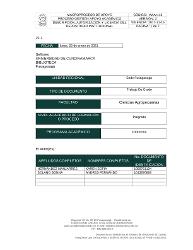| dc.description.abstract | Para determinar el uso potencial de la hoja del “naranjuelo” (Capparis odoratissima) como
fuente forrajera arbustiva en los sistemas de producción bovinos del trópico bajo
colombiano, se realizó un estudio en la zona aluvial del río Bogotá, en estivaciones a la
Cuenca del Magdalena (municipio de Girardot y Ricaurte), como representación ganadera
de gran parte del país. Se seleccionaron nueve árboles de Naranjuelo (in situ) en diferentes
estados de desarrollo (bajos, medianos y altos), colectando tres muestras de forraje por
árbol con diferente grado de madurez de la hoja (hojas jóvenes, maduras y secas). Las
muestras fueron analizadas para determinar la composición bromatológica y los resultados
de cada variable numérica fueron sometidos a un análisis estadístico de doble vía sin
interacción (DBA) para árboles y tipo de muestra, con prueba Post hoc de Duncan. Los
resultados fueron respectivamente para hojas jóvenes, maduras y secas: 42,92%±2.08%,
45,35%±2.5% y 84%±6.23% MS; 14,82%±2,81%, 17,10%±2.89% y 16,18%±3,03% MM;
85,18%±2,81%, 82,90%±2,89% y 83,82%±3,03% MO; 20,02%±1,53%, 16,02%±1,98% y
17,85%±5,99% PB; 4,41%±0,40%, 4,99%±0.75% y 4,65%±0,47% EE. La concentración de
los componentes nutricionales analizados puede ser competitivos al compararlos con la
concentración de nutrientes presentes en las principales fuentes forrajeras (principalmente
gramíneas) utilizadas en la alimentación de bovinos en el trópico. Al ser una planta
endémica puede tener beneficios en la aplicación en sistemas silvopastoriles y dar sombra
a los animales, mejorando el bienestar animal y por consecuente la producción.
To determine the potential use of “naranjuelo” leaf (Capparis odoratissima) as a shrub
forage source in the bovine production systems of the lower Colombian tropics, a study was
carried out in the alluvial zone of Bogotá River, in estivations to the Magdalena Basin
(municipality of Girardot and Ricaurte), as a livestock representation of a large part of the
country, identifying 9 Naranjuelo trees (In situ), in different stages of development that are
low, medium and high and three forage samples of each that differ in grade of maturity of
the leaf that correspond to young, mature and dry leaves. The samples were analyzed in the
animal nutrition laboratory in triplicate tests, to determine nutritional content by proximal
analysis. The results of each numerical variable were subjected a two-way statistical analysis
without interaction for trees and type of sample, with Duncan’s post hoc test. The results
were respectively for young, mature and dry leaves: 42,92%±2,08%, 45,35%±2,5% and
84%±6,23% DM; 14,82%±2,81%, 17,10%±2,89% and 16,18±3,03% MM; 85,18%±2,81,
82,90%±2,89% and 83,82%±3,03% OM; 20,02%±1,53±, 16,02%±1,98% and
17,85%±5,99% CP; 4,41%±0,40%, 4,99%±0,75% and 4,65%±0,47% EE. The concentration
of the nutritional components analyzed can be competitive when compared with the
concentration of nutrients present in the main forage sources (mainly grasses) used in the
feeding of bovines in the tropics. Being an endemic plant, it can have benefits in its
application in silvopastoral systems and provide shade for animals, improving animal welfare
and consequently production. | es_CO |



